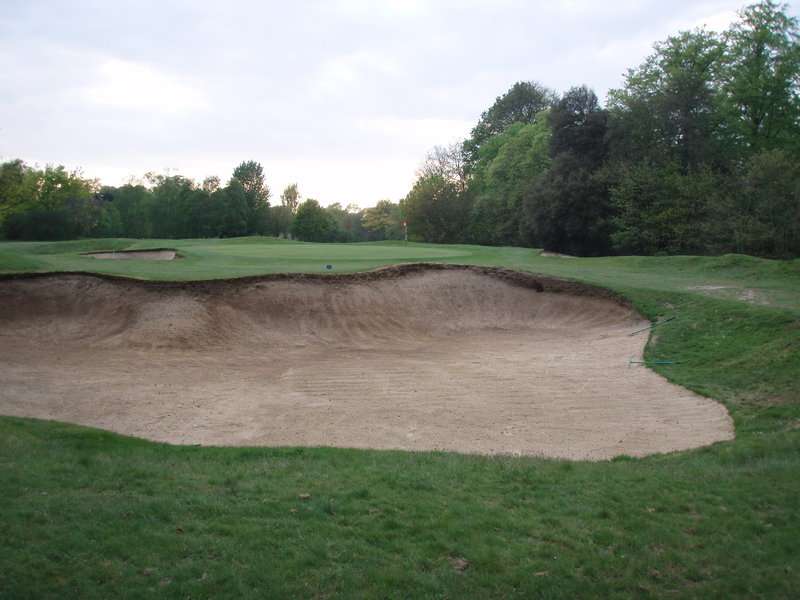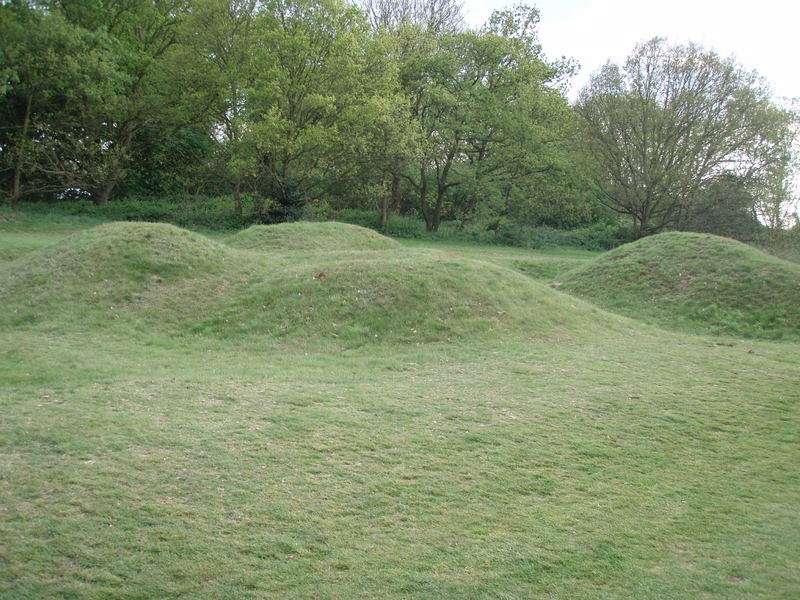A massive and rugged moat bunker fronts the green of the par three 5th (Outer) and wraps around both sides of the putting surface
What looks like a sliver of sand from the tee turns out to be a cavern of a bunker on the par four 6th (Outer)
The apline mounds and surrounding hollows are big and bold, with very few good lies to be had
Course name: Royal Mid-Surrey
Location: Richmond, London
Four Word Course Review: The birthplace of alpinisation
Royal Mid-Surrey, which has two courses designed by JH Taylor, doesn't often get a mention in discussion of the London golf landscape.
With the gems of the nearby heathland on the city's south western doorstep that's probably fair, but that certainly isn't to say the course is not important and interesting in its own right.
The Outer is the main course, originally designed as the championship course, while the Inner was designed for those seeking a bit less challenge from their round. I played a composite called the Taylor Course - which combines the front nine of the Outer and a predominantly Inner Course back nine.
Among the notable things about Royal Mid-Surrey is that it was the first course where Alpinisation was used to add interest and challenge to a very flat piece of land.
The humps and hollows are said to have been softened somewhat through the years, but they remain dramatic in many places and add good interest to many holes, guarding the ideal driving zones and causing headaches around the greens, where they can block the way and also cannon balls away from the green if an approach lands on the wrong side of the apex.
It looks as far from natural as I've seen on a golf course, but it works. I think the secret is in the boldness of the features. There's nothing half-hearted about their size or shape, which gives them the personality they need to assert themselves strategically and aesthetically.
Likewise, there is a lot of big, bold bunkering that is able to dominate several holes because the flat land is not screaming for attention itself. Great examples come at the 5th and 6th on the Outer course.
Another great example comes at a short par three played as the 16th of the Taylor Course. It measures less than 120 yards, but the green is only about 12 yards wide at the front and narrower towards the back where flanking bunkers pinch it to about seven yards. A bunker short looks to be abutting the greenfront when viewed from the tee, before being revealed to be about 20 yards short. On a piece of dead-flat land with absolutely nothing to recommend it, it's a brilliant piece of design.
Other bunkering strategies are similar to those employed by Tom Simpson to add interest to New Zealand GC's flat site: bunkers short of greens that distort your distance perception, bunkers that appear from a distance to be much smaller than they are and bunkers raised above the surrounding land to create blind areas.
It also boasts some very sandy soil and was bone dry and firm underfoot despite recent heavy rainfall, defying its unkind nickname of "Royal Mud Slurry", alluding to the suggestion it is always damp.
The club adjoins the River Thames and Kew Gardens less than half an hour by tube from the centre of London, with a massive clubhouse that bucks the trend of modern clubhouses by actually being a very appealing-looking building that, with its ample glass, appears to give a subtle nod to the wonderful greenhouses over the fence in the famous botanical gardens.
The terrain almost certainly ensured Taylor's two courses wouldn't be world class, but the inventiveness of his grass hazards combined with the bold bunkering makes Mid-Surrey a course worth playing for anyone interested in seeing how to get plenty of good golf out of a property not blessed with ample (perhaps even any) undulation.
Friday, May 07, 2010
Subscribe to:
Post Comments (Atom)



Nice write up Scott - you'll have to come back when the Outer fully re-opens. Incidentally, currently the plan is to permanently rename the courses the Taylor and the Barton to acknowledge the past great names of the club - though I'm sure the memeber will continue to refer to them as the Outer and Inner for some time.
ReplyDeleteI maintain that the above 'nick name' is only known by those who have never set foot on the course, other than the occasional flooding of a couple of holes when the Thames really gets up - just a few times a year - the course must be one of the fastest draining away from the coast!
Nice score by the way, can't believe you lost the match play having shot 3 under handicap!